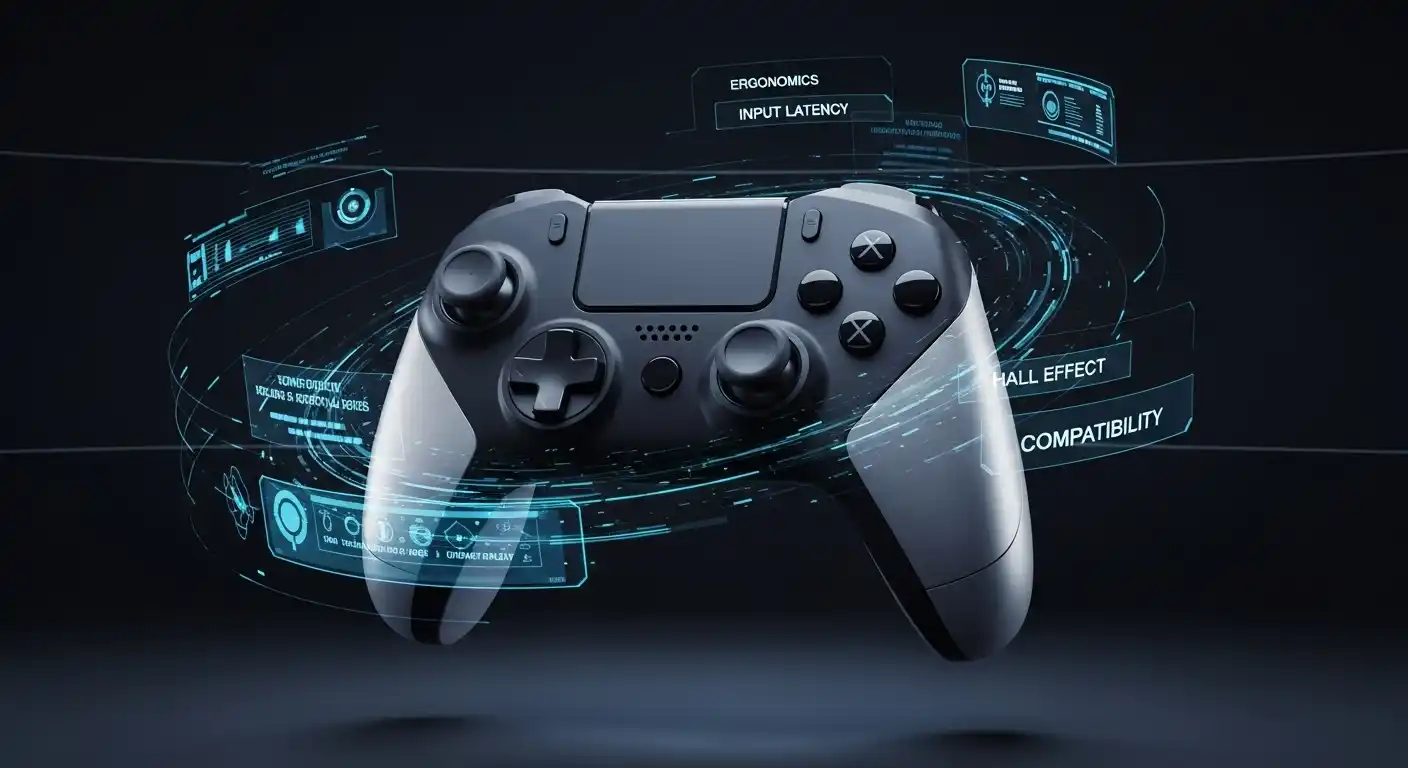In the vast, immersive universe of video games, your controller is more than a piece of plastic and circuitry. It’s your handshake with the digital world. It’s the sword in your hand, the steering wheel under your grip, the very extension of your will. Choosing the right one is one of the most critical hardware decisions a gamer can make, profoundly impacting comfort, performance, and immersion.
Yet, the market is a minefield of confusing terms, competing designs, and features that range from game-changing to pure gimmick. You’ve likely felt the frustration: the nagging ache in your hands after a long session, the sting of defeat from a delayed input, or the dreaded, infamous “stick drift” that sends your character aimlessly wandering off a cliff.
This is not just a guide. This is your comprehensive blueprint for navigating that minefield. We will dissect every critical factor, from the non-negotiable check of compatibility to the nuanced feel of ergonomics and the split-second importance of input latency. We’ll explore the cutting-edge technology like Hall Effect sensors that promise to kill stick drift for good and the “pro” features like back paddles that can give you a tangible competitive edge. By the end of this guide, you won’t just know what to look for; you will understand why it matters, empowering you to select the perfect gaming controller for your platform, your games, and your hands.
Compatibility: The First and Most Important Check
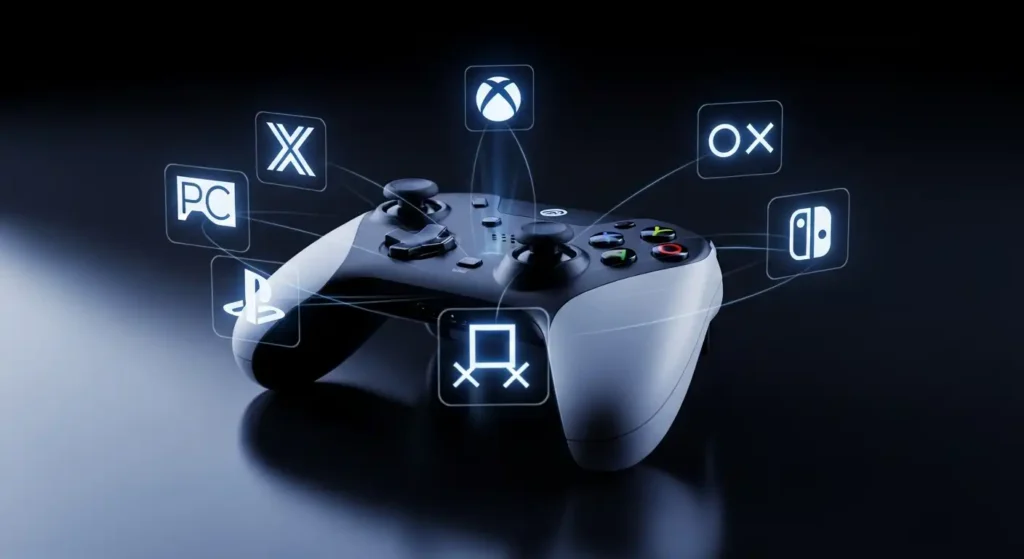
Before you fall in love with a controller’s design or features, you must answer one simple question: “Will it work with my system?” Compatibility is the foundational, non-negotiable starting point. A controller that doesn’t connect to your device is nothing more than an expensive paperweight. Let’s break down the compatibility landscape for every major platform.
For PC Gamers: XInput vs. DirectInput Explained
The PC is the most versatile gaming platform, but this versatility brings its own set of compatibility standards. For decades, two main APIs (Application Programming Interfaces) have governed how controllers talk to PC games: DirectInput and XInput.
- DirectInput: This is the older standard from Microsoft. It’s highly flexible, supporting a vast array of inputs like flight sticks, racing wheels, and complex button layouts. However, this flexibility means there’s no standardized button mapping. A game might see “Button 1” on one controller and “Button 3” on another for the same physical button, leading to frustrating manual configuration in game settings. Many older or indie titles may still rely on DirectInput.
- XInput: Introduced with the Xbox 360, XInput is the modern, streamlined standard. It has a fixed, standardized layout that mirrors the Xbox controller (A, B, X, Y, LB, RB, LT, RT, etc.). When you plug in an XInput controller, Windows and the vast majority of modern games instantly recognize it and map the buttons correctly. It is the “plug-and-play” standard for PC gaming today.
Your takeaway as a PC gamer: Unless you have a specific need for an older game, you should always prioritize a controller with XInput support. Nearly all modern PC-compatible controllers use XInput as their primary mode. Some offer a switch to toggle between XInput and DirectInput for maximum compatibility, which is a fantastic bonus feature.
For Xbox Series X|S & Xbox One
Microsoft has made compatibility within its ecosystem exceptionally simple. Any officially licensed controller that works on an Xbox One will also work seamlessly on an Xbox Series X and Series S, and vice versa. This includes:
- The Official Xbox Wireless Controller: This is the gold standard and the benchmark against which all others are measured. It uses Microsoft’s proprietary wireless protocol for a rock-solid, low-latency connection.
- The Xbox Elite Series 2 Controller: The premium “pro” version with swappable components and back paddles.
- Third-Party Licensed Controllers: Companies like PowerA, Razer, and Turtle Beach make excellent wired and wireless controllers designed specifically for the Xbox ecosystem. If it has the “Designed for Xbox” seal, you can buy it with confidence.
For PlayStation 5 & PlayStation 4
Sony’s ecosystem is slightly more locked down. The key distinction lies in which games you want to play.
- The PS5 DualSense Controller: This is the required controller to play PS5-native games. Its advanced features, like adaptive triggers and sophisticated haptic feedback, are integral to the PS5 experience. No third-party controller can currently replicate this functionality in PS5 titles.
- The PS4 DualShock 4 Controller: You can use a DualShock 4 on a PS5, but only to play backward-compatible PS4 games. It will not function as the primary controller for PS5 games.
- Third-Party PS4 Controllers: Licensed PS4 controllers from brands like Nacon and Razer will also work on the PS5 for playing PS4 games. Some specialized third-party “pro” controllers for PS5 exist, but they often achieve this by sacrificing features like haptic feedback or by requiring a genuine DualSense to be plugged in for authentication.
For Nintendo Switch
The Nintendo Switch offers a few distinct controller options, each catering to a different use case.
- Joy-Con Controllers: The default controllers that come with the console. Their modularity is their strength, but many gamers find them too small for comfortable long-term play in a traditional grip.
- Nintendo Switch Pro Controller: This is Nintendo’s answer to the traditional gamepad. It offers fantastic ergonomics, excellent battery life, and a more conventional feel for games like The Legend of Zelda or Super Smash Bros. Ultimate.
- Third-Party Controllers: The market for Switch controllers is enormous. Brands like 8BitDo and PowerA offer a huge variety of styles, from modern gamepads to retro-inspired designs. When buying a third-party Switch controller, check specifically for features like motion controls (gyro) and NFC support (for Amiibo), as these are sometimes omitted to reduce cost.
What About Mobile Gaming? (iOS & Android)
Mobile gaming has matured into a serious platform. Both iOS and Android now offer robust, native support for modern console controllers. You can easily connect an Xbox Wireless Controller or a PS5 DualSense controller via Bluetooth to your smartphone or tablet for a console-quality experience in games that support it, like Call of Duty: Mobile or through cloud gaming services like Xbox Cloud Gaming.
Additionally, specialized mobile controllers like the Razer Kishi or Backbone One physically attach to your phone, turning it into a Switch-like handheld device. These offer a zero-latency connection and a more integrated, portable form factor.
Ergonomics and Design: How It Feels in Your Hands
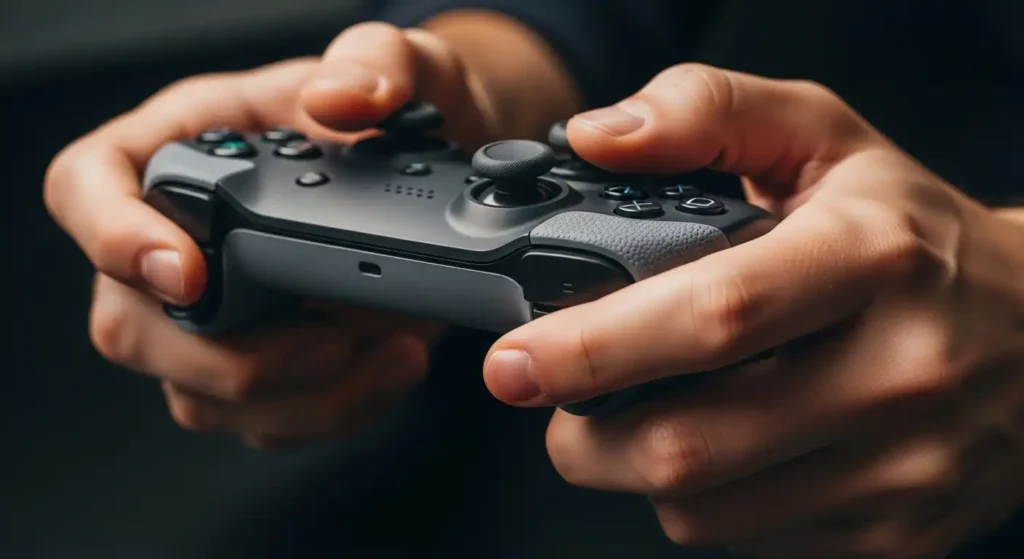
Once you’ve confirmed compatibility, ergonomics becomes the most critical personal factor. A controller’s features are meaningless if holding it causes cramps or discomfort. Poor ergonomics isn’t just a minor issue—it can cause physical strain, pull you out of the game, and actively hinder your performance.
Since everyone’s hands and grip styles are different, what feels perfect to one person may feel awkward to another. Let’s break down the key design elements to help you find a controller that feels like it was truly made for you.
The Great Debate: Symmetric vs. Asymmetric Thumbsticks
This is the most defining ergonomic feature and the primary point of division in controller design, originating from the classic PlayStation vs. Xbox rivalry.
- Symmetric Layout (PlayStation Style): Both analog sticks are positioned parallel to each other on the lower half of the controller. Proponents argue this feels more balanced and natural for games where you use both sticks equally, like sports titles (FIFA, NBA 2K). The D-pad is given the primary thumb position on the left, which can be preferable for 2D platformers or fighting games.
- Asymmetric Layout (Xbox Style): The left analog stick is raised, swapping places with the D-pad. The logic here is that in most modern 3D games, your left thumb is on the analog stick for movement almost 100% of the time, while the D-pad is used for secondary functions (like switching weapons). This layout places the primary input for each thumb in its most natural, resting position.
There is no “better” layout; it is purely a matter of preference, often dictated by what you grew up playing. If you’re unsure, the asymmetric layout is generally considered slightly more ergonomic for the majority of modern 3D titles.
Size, Shape, and Weight: Finding Your Perfect Fit
Controllers are not one-size-fits-all.
- Size: The Xbox controller is generally larger and beefier than the PlayStation DualSense, which itself is larger than its predecessor, the DualShock 4. Gamers with smaller hands might find a larger controller causes them to stretch uncomfortably, while those with larger hands might feel cramped on a smaller device.
- Shape: Look at the contours of the grips. Are they long and straight, or are they more bulbous and curved to fill your palm? The shape dictates how naturally the controller rests in your hands without you having to actively “hold” it.
- Weight: Weight contributes to the feeling of “premiumness” but can also lead to fatigue. A very light controller might feel cheap and toy-like, while an overly heavy one can strain your wrists over several hours. The Xbox Elite Series 2, for example, is noticeably heavier than the standard controller, which some love and others dislike.
Grip and Texture: How Materials Impact Control and Comfort
The material finish of a controller is crucial for maintaining control during tense gaming moments.
- Standard Plastic: Most base controllers use a simple matte or textured plastic. It’s durable and cost-effective but can become slippery if your hands get sweaty.
- Rubberized Grips: A premium feature found on many “pro” controllers. Textured rubber panels are added to the areas where your palms and fingers rest. This dramatically increases grip and control, providing a secure, comfortable feel that is less prone to slipping.
- Texturing: Look for fine texturing on the back of the controller and on the triggers and thumbsticks. Even a subtle pattern, like the micro-dots on the back of the Xbox Series controller, can make a significant difference in preventing your fingers from sliding.
Performance and Connectivity: The Core of Your Gameplay
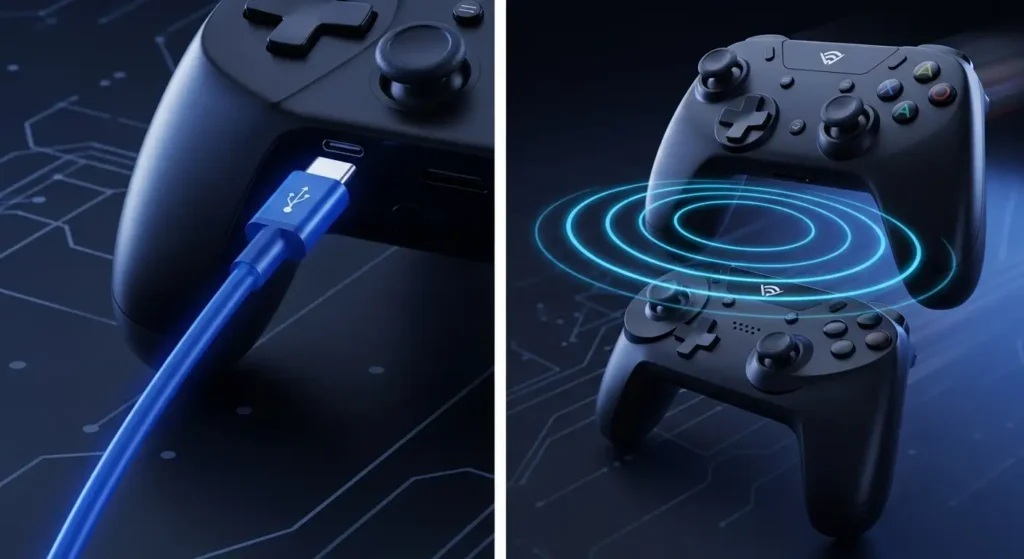
Now we transition from the subjective world of feel to the objective realm of function. The performance of your controller is its technical heart, determining how quickly and reliably your physical actions are translated into digital commands. This is where the subtlest of delays can be the difference between a clutch victory and a frustrating defeat.
At the core of controller performance are two key metrics: input latency and connection stability. Latency measures the time it takes for your button press to register in-game, while stability ensures that the signal remains strong and consistent, free from dropouts or interference. Together, these factors define the responsiveness and reliability of your connection to the game world.
Wired vs. Wireless: A Battle of Latency and Freedom
The choice between a wired and wireless controller is a trade-off between ultimate performance and ultimate convenience.
- Wired Controllers:
- Pros: The primary advantage is a near-zero latency connection. By plugging directly into the console or PC via USB, the signal path is as clean as possible. They also never need to be charged and are generally less expensive.
- Cons: The obvious drawback is the cable. It can limit your distance from the screen, create clutter, and be a potential trip hazard.
- Wireless Controllers:
- Pros: The freedom is undeniable. You can sit comfortably on your couch, lean back in your chair, and never worry about yanking a cable. Modern wireless technology is also exceptionally good.
- Cons: They introduce a small amount of input latency, though it’s often imperceptible to most players. They rely on battery power and require regular charging. They can also be susceptible to wireless interference from other devices, though this is rare with modern protocols.
Wireless Technology Breakdown:
- 2.4GHz Wireless (via Dongle): This is the preferred method for high-performance wireless gaming on PC. The controller comes with a dedicated USB dongle that creates a private, low-interference, high-speed connection. It offers latency that is virtually indistinguishable from a wired connection.
- Bluetooth: This is a more universal standard used for connecting to mobile devices, laptops, and some PCs. It’s incredibly convenient but generally has slightly higher latency and can be more prone to interference than a dedicated 2.4GHz connection.
Understanding Input Latency (and Why It Matters for Competitive Play)
Input latency (or input lag) is the tiny delay between you performing an action on the controller and that action appearing on screen. It’s measured in milliseconds (ms). For a casual single-player RPG, a latency of 20-30ms is completely unnoticeable. However, in high-stakes competitive games like a fighting game (Street Fighter) or a first-person shooter (Call of Duty), every millisecond counts.
A top-tier wired controller or a high-performance 2.4GHz wireless controller will have a latency well under 10ms. A standard Bluetooth controller might be in the 15-25ms range. While most gamers won’t perceive this difference, elite players will, as it can be the difference between successfully parrying an attack or getting hit. For the vast majority of players, the latency of modern first-party wireless controllers (Xbox, PlayStation, Nintendo) is more than good enough for any type of game.
Battery Life and Charging Options for Wireless Controllers
If you go wireless, battery life becomes a key consideration. Nothing is worse than your controller dying in the middle of a boss fight.
- Battery Type:
- Built-in Rechargeable (PlayStation/Nintendo): These controllers have an internal lithium-ion battery. You charge them via a USB cable (typically USB-C on modern models). It’s convenient, but if the battery degrades over time, it’s not easily replaceable.
- AA Batteries / Optional Play & Charge Kit (Xbox): Standard Xbox controllers come with disposable AA batteries. Many users immediately purchase a “Play & Charge Kit,” which is a rechargeable battery pack that can be charged inside the controller via USB-C. This offers flexibility: you can use AAs in a pinch or rely on the rechargeable pack.
- Battery Longevity: This varies wildly. The Nintendo Switch Pro Controller is the champion, often lasting 40+ hours. The Xbox controller with a good rechargeable pack typically gets 20-30 hours. The PS5 DualSense, with its advanced haptics enabled, has the shortest life, often tapping out around 8-12 hours.
Key Features and Advanced Customization
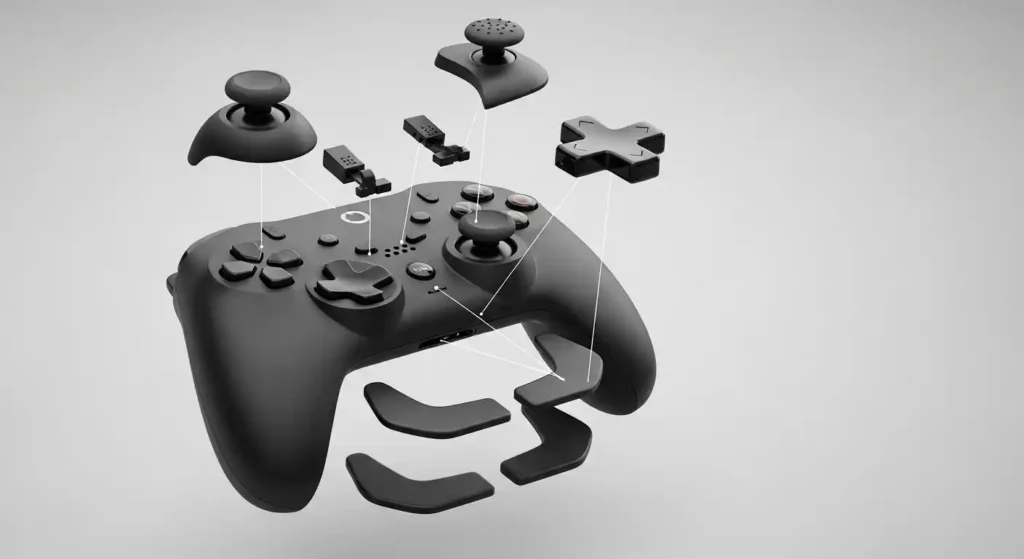
Having mastered the fundamentals of compatibility, ergonomics, and performance, we now ascend to the features that truly distinguish a basic gamepad from elite, “pro-level” hardware. This is the world of cutting-edge technology and deep customization, where controllers evolve from simple input devices into highly-tuned instruments of play.
These advanced features are not mere novelties; they are purpose-built to deliver tangible benefits. They are engineered to solve long-standing problems like stick drift, to grant you superior control through modular components, and to provide a measurable competitive advantage with additions like back paddles. Investing in these features is an investment in your controller’s longevity and your own in-game potential.
Analog Sticks: The Hall Effect Revolution Against Stick Drift
This is arguably the single most important innovation in controller technology in the last decade. Stick drift—where the analog stick sends an input even when it’s not being touched—is a plague caused by the physical degradation of standard potentiometers.
- Standard Potentiometers: Traditional analog sticks work by having a physical electrical wiper scrape across a resistive track. Over thousands of hours of use, this track wears down, creating “dead zones” and inaccuracies that result in drift. It’s a mechanical failure waiting to happen.
- Hall Effect Sensors: This revolutionary technology eliminates physical contact. It works using magnets. A magnet is placed at the bottom of the stick, and sensors measure the changes in its magnetic field as you move it. Because nothing is physically rubbing or scraping, there is no mechanical wear and tear. Hall Effect sticks are, in theory, immune to stick drift. Controllers from brands like GameSir and 8BitDo are leading the charge in adopting this technology, and it’s a massive selling point for long-term durability.
Buttons and D-Pads: From Standard Membranes to Tactile Clicks
Not all buttons are created equal.
- Membrane Buttons: This is the standard for most controllers. You press the button, which pushes down on a squishy rubber dome, which then makes contact with the circuit board. It feels soft and is relatively quiet.
- Mechanical Microswitches: Found on some premium controllers (like the Razer Wolverine series), these use the same kind of switches you’d find in a gaming mouse. They provide a distinct, satisfying, and audible “click” with a much shorter actuation distance. This tactile feedback can improve responsiveness and the feeling of precision, though some may find them too loud.
- The D-Pad: The directional pad is critical for fighting games and 2D platformers. Some are a single, solid piece (like on the Xbox Elite), which is great for “rolling” inputs. Others are four separate buttons (like on the PlayStation), which can feel more precise for distinct directional taps. The best D-pads offer a perfect balance of tactile feedback and ease of movement.
Triggers: Standard, Analog, and Adaptive Explained
The top shoulder buttons, or triggers, have also evolved significantly.
- Digital Triggers: These are simple on/off buttons. You press them, they activate.
- Analog Triggers: These are pressure-sensitive. The further you depress the trigger, the greater the input. This is essential for racing games, where the trigger acts like a real gas pedal, allowing for fine control over acceleration.
- Trigger Stops: A common “pro” feature. This is a physical switch that dramatically shortens the travel distance of the trigger. In an FPS game, you don’t need the full analog range; you just want to fire as quickly as possible. A trigger stop turns a long analog pull into a short, mouse-like click, speeding up your reaction time.
- Adaptive Triggers (PS5 DualSense Exclusive): This is a groundbreaking feature where developers can programmatically change the tension and feedback of the triggers. Drawing a bowstring in a game can make the trigger feel tense and resistant, while firing a gun can provide a sharp kickback. It’s a powerful tool for immersion.
Pro Features: Remappable Buttons and Back Paddles
This is the defining characteristic of a “pro” controller.
- Remappable Buttons: This allows you to change what any button on the controller does, usually through software on your PC or console. You can swap X and O, for example, to match a different region’s standard layout.
- Back Paddles: These are the ultimate competitive advantage. Paddles are levers or buttons added to the back of the controller where your middle fingers naturally rest. You can map face button actions (like A for jump, or B for crouch) to these paddles. The benefit is immense: In an FPS, you can now jump, reload, or switch weapons without ever taking your right thumb off the aiming stick. This allows for a level of fluid movement and aiming that is impossible on a standard controller. Once you get used to paddles, it’s incredibly difficult to go back.
Rumble and Haptic Feedback: Feeling the Game
Feedback is a key part of immersion.
- Standard Rumble: Uses unbalanced spinning motors in the controller grips to create vibrations for explosions, crashes, and other in-game events. It’s effective but not very nuanced.
- Advanced/HD Haptics (DualSense & Switch Pro): This uses more precise voice coil actuators, similar to what’s in your smartphone. It can produce a huge range of highly localized and detailed sensations, from the pitter-patter of raindrops to the metallic clang of a sword strike. The PS5’s DualSense has the most advanced implementation, providing a layer of sensory feedback that truly enhances the gaming experience.
Making Your Final Choice & Next Steps
You are now armed with an expert-level understanding of every component that makes a gaming controller great. You can speak the language of latency, ergonomics, and haptics. The final, crucial step is to synthesize this powerful knowledge and use it as a framework for your personal decision.
This means considering your primary gaming platform, the genres you play most, and the features you value above all others. It’s a process of weighing trade-offs: are you willing to sacrifice some battery life for state-of-the-art haptics? Are back paddles more important to you than Hall Effect sticks?
Ultimately, this guide’s purpose is to destroy the myth of a single “best” controller. That product doesn’t exist. Instead, our goal is to empower you to find the controller that is, without question, the absolute best for you.
The Best of Both Worlds? When to Use a Controller vs. a Gaming Mouse
While this guide is focused on controllers, it’s important to acknowledge they aren’t always the best tool for the job. For many PC genres, the keyboard and mouse reign supreme.
- Use a Controller for: Racing games, sports titles, third-person action/adventure games, 2D platformers, and fighting games. The analog stick offers nuanced movement control that a keyboard’s on/off WASD keys can’t match.
- Use a Mouse & Keyboard for: First-person shooters (FPS) and strategy games (RTS/MOBAs). While a controller offers comfort, for pure aiming precision in titles like Valorant or CS:GO, nothing beats the speed and 1:1 control of a high-quality [How to Choose a Gaming Mouse: The Ultimate 2025 Guide]. The large surface area of a mousepad allows for a range of motion and pinpoint accuracy that an analog stick simply cannot replicate.
Many gamers use both, switching inputs depending on the game they’re playing to get the best experience possible.
H3: The Perfect Controller for Your Favorite Genre
To simplify your decision, here’s a quick breakdown of which features to prioritize based on the games you play most:
| Game Genre | Primary Features to Prioritize | “Nice-to-Have” Features |
| First-Person Shooters (FPS) | Asymmetric Layout, Back Paddles, Trigger Stops, High-Grip Surfaces | Mechanical Buttons, Hall Effect Sticks |
| Racing & Driving Sims | Analog Triggers, Strong Rumble/Haptics, Comfortable Ergonomics | Swappable Thumbsticks, Good D-Pad |
| Fighting Games & 2D Platformers | High-Quality D-Pad, Low Latency (Wired/2.4Ghz), Mechanical Buttons | Symmetric Layout, Remappable Buttons |
| Third-Person Action/Adventure | Overall Comfort, Good Battery Life, Advanced Haptics (PS5) | Back Paddles, Hall Effect Sticks |
| Sports Games (FIFA, NBA 2K) | Symmetric Layout, Durable Analog Sticks (Hall Effect is a plus) | Good Battery Life, Remappable Buttons |
Ready to See the Best? Our Top Controller Picks for 2025
Now that you’re armed with all this knowledge, it’s time to see these principles in action. We’ve taken everything discussed in this guide and applied it to the best products on the market. Whether you’re looking for the top pro-level device, the best budget option, or the most durable controller available, our detailed breakdown will guide you to the perfect choice.
Top 10 Gaming Controllers Ranked by User Experience in 2025
Conclusion
Your controller is your most intimate connection to the games you love. By moving beyond marketing hype and focusing on the core principles of compatibility, ergonomics, performance, and features, you’ve empowered yourself to make an informed choice. Remember the key takeaways: prioritize compatibility first, never underestimate the personal feel of ergonomics, demand durability with features like Hall Effect sticks, and consider pro features like back paddles if you’re seeking a competitive edge. The perfect controller is out there waiting for you, and now you have the map to find it.
Frequently Asked Questions About Gaming Controllers
Here are answers to some of the most common questions gamers have when choosing a new controller.
Is a “pro” controller really worth the money?
A: A “pro” controller is worth it if you are a competitive player seeking a tangible advantage. The key features—back paddles and trigger stops—allow you to perform actions like jumping and shooting faster without moving your thumbs from the analog sticks. For casual gamers, the high cost may not be justified, but for those serious about performance in FPS or action games, the investment is often considered a game-changer.
What actually causes controller stick drift?
A: Stick drift is a physical hardware failure. Most standard controllers use potentiometers in their analog sticks, which rely on a small mechanical wiper scraping across a resistive track to register movement. Over time, this scraping wears down the track, creating “dead zones” and inaccuracies that cause the controller to send an input even when the stick isn’t being touched.
What are Hall Effect controllers and why are they better?
A: Hall Effect controllers use magnets and magnetic sensors to detect analog stick movement instead of physical, rubbing parts. Because there is no mechanical friction or wear, they are immune to the degradation that causes stick drift. Choosing a controller with Hall Effect sticks is the single best way to ensure its long-term durability and accuracy.
Is a wired or wireless controller better for gaming?
A: For pure, split-second competitive performance, a wired controller technically offers the lowest possible input latency. However, modern 2.4GHz wireless technology (using a dedicated USB dongle) is so fast that the latency is virtually indistinguishable from wired for all but the most elite professional players. The freedom and convenience of wireless make it the better choice for the vast majority of gamers today.
Can I use my PS5 DualSense controller on a PC?
A: Yes, you can use a PS5 DualSense controller on a PC, either wired via USB-C or wirelessly via Bluetooth. Steam has excellent built-in support for it. However, be aware that advanced features like the adaptive triggers and sophisticated haptic feedback are not supported in most PC games, though some titles are beginning to add native support.
How long should a gaming controller last?
A: The lifespan of a gaming controller depends heavily on usage and build quality. A standard controller under heavy use can develop issues like stick drift within 1-2 years. Premium controllers with more durable components may last 3+ years. Controllers with future-proof technology like Hall Effect sensors and mechanical buttons are designed to last significantly longer, as they eliminate the most common points of mechanical failure.
